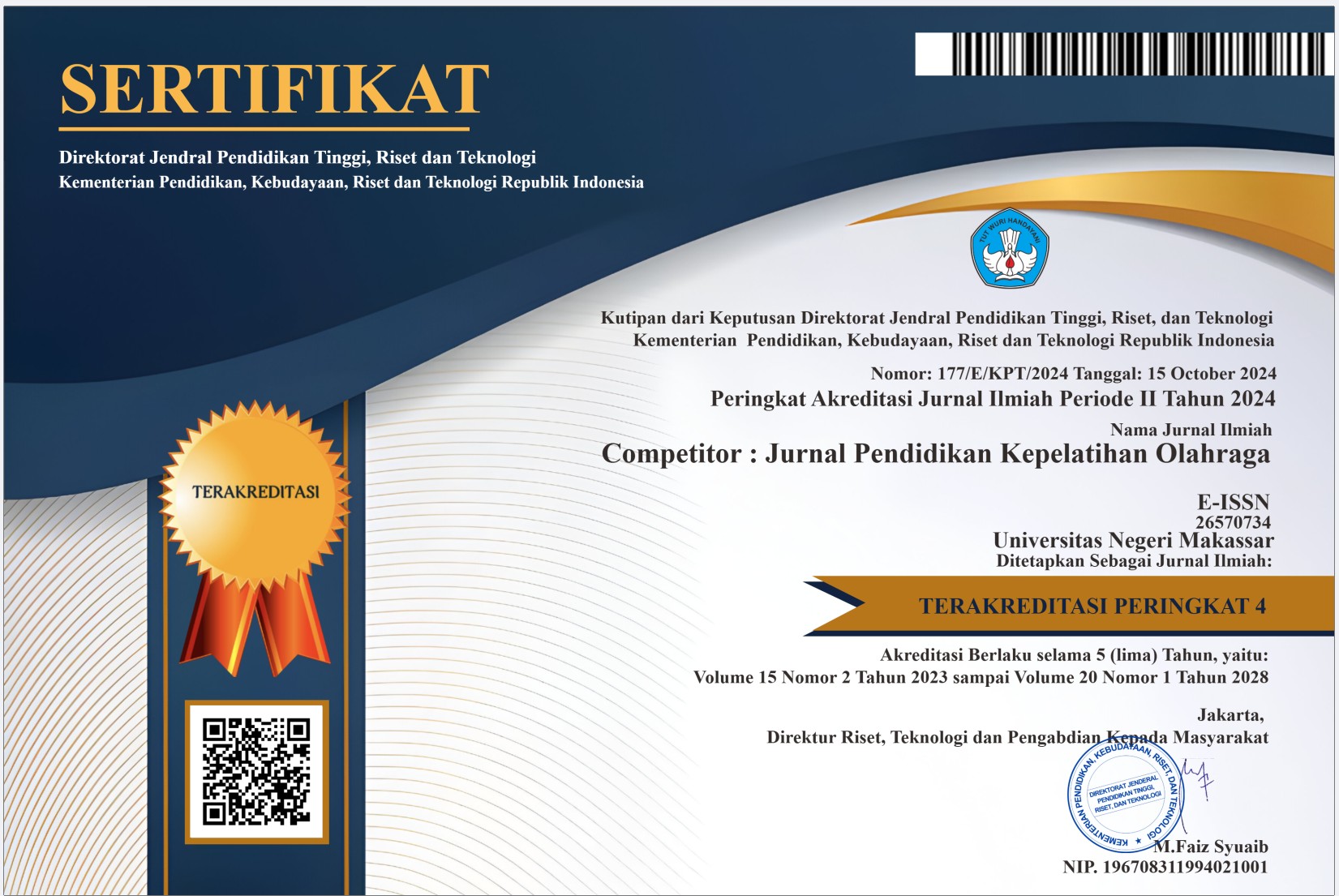Analysis of The Use of Behaviorism Theory in Physical Education Learning on Student Discipline in Elementary Schools
DOI:
https://doi.org/10.26858/cjpko.v17i1.69611Keywords:
Behaviorism, Learning, Physical Education, Discipline.Abstract
This study aims to analyse the application of behaviourism theory in physical education (PE) learning to improve student discipline in elementary schools. The qualitative research method with a case study approach involved in-depth interviews with three PE teachers from elementary schools in Sumedang. Data were collected through interviews and documentation and then analyzed using triangulation techniques to ensure the validity of the research results. The results showed that the application of behaviourism theory, through positive reinforcement such as praise and rewards, as well as negative reinforcement such as educational reprimands, was able to improve student discipline. These strategies include routine activities such as line setting, collective prayer, and warm-ups that help students understand the importance of order. Adaptive approaches, such as tailoring learning methods to students' interests, were also found to be effective in improving discipline. This study concludes that the application of behaviourism theory in PE learning not only improves student discipline but also creates a conducive learning environment. Appropriate behaviour reinforcement strategies can help students develop disciplinary habits and other positive characteristics early on.References
Amir. 2006. Pendidikan Jasmani dan Kesehatan. Yogyakarta : Kanisius
Claver, F., Martínez-Aranda, L., Conejero, M., & Gil-Arias, A. (2020). Motivation, Discipline, and Academic Performance in Physical Education: A Holistic Approach From Achievement Goal and Self-Determination Theories. Frontiers in Psychology, 11. https://doi.org/10.3389/fpsyg.2020.01808.
Creswell, J. W., & Poth, C. N. (2016). Qualitative inquiry and research design: Choosing among five approaches. Sage publications. https://bit.ly/49RVYCl
Halimah, Nurul. "Analisis pembelajaran berdiferensiasi sebagai bentuk implementasi kebijakan kurikulum merdeka." Pendas: Jurnal Ilmiah Pendidikan Dasar 8.1 (2023): 5019-5019.
Hasmar, Titi Putiha, and Wayan Tamba. "Pengaruh Pemberian Reward Terhadap Peningkatan Karakter Disiplin Anak Usia Dini Di TK Al-Azhar Sandubaya." Transformasi: Jurnal Penelitian dan Pengembangan Pendidikan Non Formal Informal 7.1 (2021): 29-34. https://doi.org/10.26858/CJPKO.V13I1.18131.
Husdarta. 2009. Pendidikan Jasmani, Kesehatan, dan Rekreasi. Jakarta: Gramedia
Mustafa, P. (2021). Implementation Of Behaviorism Theory-Based Training Learning Model In Physical Education In Class Vii Junior High School Football Game Materials. , 13, 39-60.
Nugraha, D. (2021). Penerapan Metode Pembelajaran yang Efektif untuk Meningkatkan Disiplin Siswa dalam Penjas. Jurnal Pendidikan Fisik, 9(3), 21-28.
Palupi, E. R. R., Utami, W., & Munfarida, A.I. (2023). Pengaruh Kombinasi Terapi Bermain Playdough Dan Origami Dalam Peningkatan Konsentrasi Belajar Pada Anak Hiperaktif. Jurnal Insan Cendekia,10(3),160-171. https://doi.org/10.35874/jic.v10i3.1229.
Quintas-Hijós, A., Peñarrubia-Lozano, C., & Bustamante, J. C. (2020). Analysis of the applicability and utility of gamified didactics with exergames at primary schools: Qualitative findings from a natural experiment. PloS one, 15(4), e0231269.
Santrock, J. W. (2011). Educational psychology. McGraw-Hill. https://thuvienso.hoasen.edu.vn/handle/123456789/8796
Skinner, B.F. (1974). About Behaviorism. Alfred A. Knopf.
Strauss, A., & Corbin, J. (2003). Penelitian kualitatif. Yogyakarta: Pustaka Pelajar, 165. http://repo.iain-tulungagung.ac.id/7300/10/Bab10_Penelitian%20Kualitatif_3.pdf
Suprapto, A. (2020). Faktor-Faktor yang Mempengaruhi Kedisiplinan Siswa dalam Pembelajaran Penjas di Sekolah Dasar. Jurnal Pendidikan Dasar, 8(1), 55-62.
Suryadi, D. (2019). Pendidikan Jasmani untuk Meningkatkan Kedisiplinan Siswa Sekolah Dasar. Jurnal Pendidikan Olahraga, 6(2), 35-42.
Tauhid, R. (2020). Dasar-Dasar Teori Pembelajaran. JURNAL PENDAS (Pendidikan Sekolah Dasar), 2(2), 32-38.
Thorndike, E.L. (1932). The Principles of Teaching. Teachers College, Columbia University.
Titik, N. I. (2019) ‘Pengembangan Instrumen Pengukuran Disiplin Siswa’, Wiyata Dharma: Jurnal Penelitian Dan Evaluasi Pendidikan, 7(1), Pp. 46–55.
Wahab, Gusnarib, and R. Rosnawati. "Teori-teori belajar dan pembelajaran." Erlangga, Bandung (2011).
Wanabuliandari, S. D. A. S., & Rahardjo, S. (2017). Peningkatan perilaku peduli lingkungan dan tanggung jawab siswa melalui model ejas dengan pendekatan science edutainment. Jurnal Ilmiah Pendidikan Dasar, 4(1), 1-7.
Watson, J.B. (1924). Behaviorism. W. W. Norton & Company.
Downloads
Published
Issue
Section
License
Copyright (c) 2025 Fadya Nurfitri, Muhammad Arfrizal Suhenda Putra, Qory Maryam An Naba, Raihan Aslamul Hikam, Rijal Ahmad Fauji (Author)

This work is licensed under a Creative Commons Attribution 4.0 International License.





















